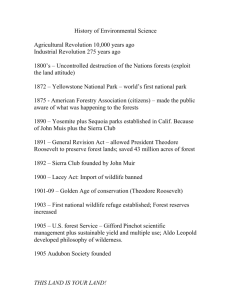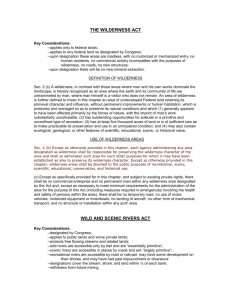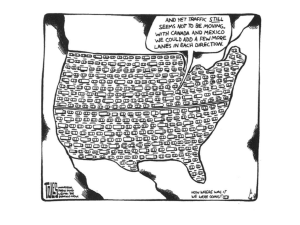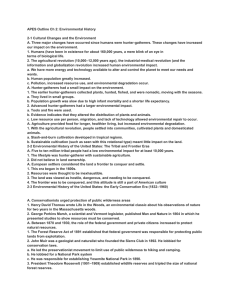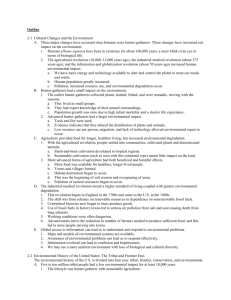Glossary of Public Lands Terms and Acronyms
advertisement
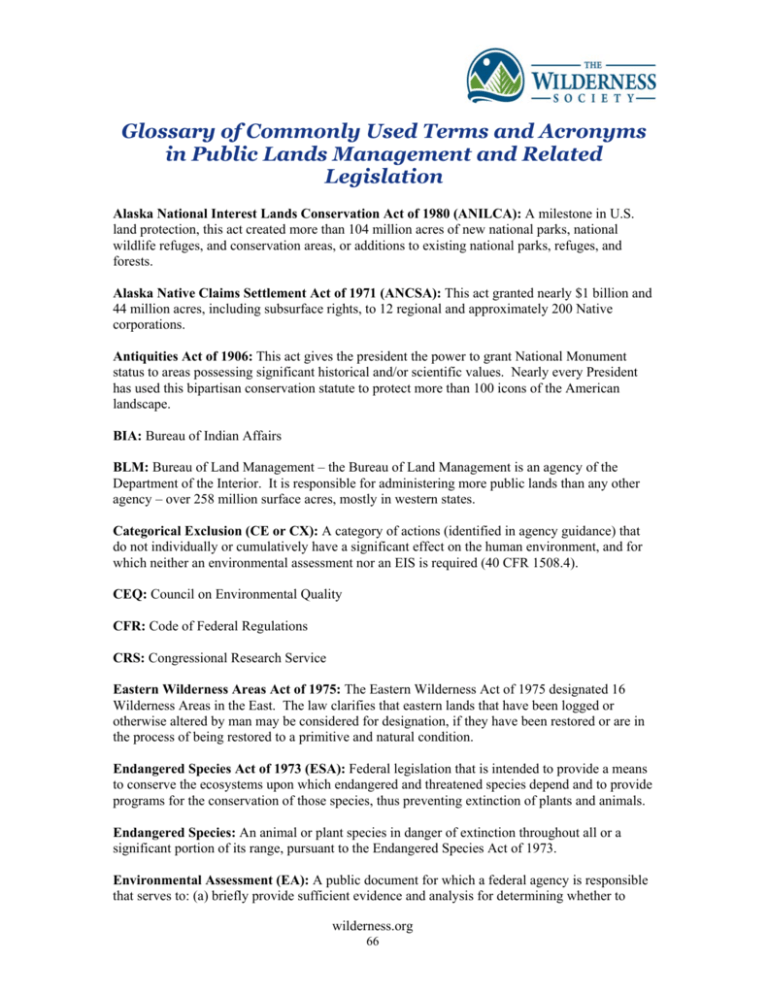
Glossary of Commonly Used Terms and Acronyms in Public Lands Management and Related Legislation Alaska National Interest Lands Conservation Act of 1980 (ANILCA): A milestone in U.S. land protection, this act created more than 104 million acres of new national parks, national wildlife refuges, and conservation areas, or additions to existing national parks, refuges, and forests. Alaska Native Claims Settlement Act of 1971 (ANCSA): This act granted nearly $1 billion and 44 million acres, including subsurface rights, to 12 regional and approximately 200 Native corporations. Antiquities Act of 1906: This act gives the president the power to grant National Monument status to areas possessing significant historical and/or scientific values. Nearly every President has used this bipartisan conservation statute to protect more than 100 icons of the American landscape. BIA: Bureau of Indian Affairs BLM: Bureau of Land Management – the Bureau of Land Management is an agency of the Department of the Interior. It is responsible for administering more public lands than any other agency – over 258 million surface acres, mostly in western states. Categorical Exclusion (CE or CX): A category of actions (identified in agency guidance) that do not individually or cumulatively have a significant effect on the human environment, and for which neither an environmental assessment nor an EIS is required (40 CFR 1508.4). CEQ: Council on Environmental Quality CFR: Code of Federal Regulations CRS: Congressional Research Service Eastern Wilderness Areas Act of 1975: The Eastern Wilderness Act of 1975 designated 16 Wilderness Areas in the East. The law clarifies that eastern lands that have been logged or otherwise altered by man may be considered for designation, if they have been restored or are in the process of being restored to a primitive and natural condition. Endangered Species Act of 1973 (ESA): Federal legislation that is intended to provide a means to conserve the ecosystems upon which endangered and threatened species depend and to provide programs for the conservation of those species, thus preventing extinction of plants and animals. Endangered Species: An animal or plant species in danger of extinction throughout all or a significant portion of its range, pursuant to the Endangered Species Act of 1973. Environmental Assessment (EA): A public document for which a federal agency is responsible that serves to: (a) briefly provide sufficient evidence and analysis for determining whether to wilderness.org 66 prepare an Environmental Impact Statement or a finding of no significant impact; (b) aid an agency's compliance with the National Environmental Policy Act (NEPA) when no Environmental Impact Statement is necessary; (c) facilitate the preparation of a statement when one is necessary. An EA includes brief discussions of the need for the proposal and of the environmental impacts of the proposed action and other alternatives. Environmental Impact Statement (EIS): A written analysis of the impacts on the natural, social, and economic effects of a proposed project or resource management plan. EPA: Environmental Protection Agency FACA: Federal Advisory Committee Act of 1997 Federal Land or ‘Public Land’: Land owned by the United States, without reference to how the land was acquired or which federal agency administers the land, including mineral and coal estates underlying private surface. Federal Land Policy and Management Act of 1976 (FLPMA): Referred to as the “enabling” or “organic” legislation for the BLM, this Act gives the BLM legal authority to establish public land policy, to establish guidelines for administering such policy and to provide for management, protection, development and enhancement of the public land. FLTRA: Federal Land Transaction Facilitation Act of 2000 FOIA: Freedom of Information Act Forest Legacy Program: Congress authorized the Forest Legacy Program in 1990. The program helps preserve working forestlands and protect critical forest resources. It has a minimum requirement of 25 percent non-federal matching funds thereby leveraging state and private dollars to complement federal money. FONSI: Finding of No Significant Impact FWS: Fish and Wildlife Service GAO: Government Accountability Office Healthy Forests Initiative (HFI): A series of regulatory and Administrative changes instituted by the Bush Administration in August of 2002 with the intent to “to reduce the risks severe wildfires pose to people, communities, and the environment”. Administrative actions undertaken through HFI include: new categorical exclusions for certain fuel-treatment projects and fire rehabilitation projects; new guidance from the Council on Environmental Quality to conduct environmental assessments for fuel reduction; new Forest Service and Interior appeals rules amendments; and new Endangered Species Act procedures for hazardous fuel projects. Healthy Forests Restoration Act (HFRA): A law enacted in December of 2003 that contains a variety of provisions for expediting hazardous fuel reduction on specific types of Federal land that are at risk of wildland fire or insect and disease epidemics. It provides expedited environmental analysis of fuel-treatment projects, administrative review before decisions are issued, and requires collaboration between federal agencies and local communities, particularly wilderness.org 67 when Community Wildfire Protection Plans are prepared. It requires that at least 50 percent of the dollars allocated to HFRA projects are to protect communities at risk of wildland fire. IBLA: Interior Board of Land Appeals Inventoried Roadless Areas: Areas as defined under the Roadless Area Conservation Rule of 2001. Land and Water Conservation Fund (LWCF): In 1964, Congress established the Land and Water Conservation Fund to preserve America's lands and waters using revenues from offshore oil and gas drilling. Congress is authorized to appropriate up to $900 million a year between the Federal and state grants components of the program. Leasable Minerals: Minerals such as coal, oil shale, oil and gas, phosphate, potash, sodium, geothermal resources, and all other minerals occurring on federal public lands that may be leased for extraction under the Mineral Leasing Act of 1920, as amended. Locatable Minerals: A mineral subject to claim location under the 1872 mining laws. Examples of such minerals would be gold, silver, copper and lead as compared to oil and natural gas, which are leasable minerals. MMPA: Marine Mammal Protection Act of 1972 MOU: Memorandum of Understanding Multiple Use-Sustained Yield Act of 1960: Directs the Secretary of Agriculture to consider “the relative values of the various resources in National Forests, and not necessarily the combination of uses that will give the greatest dollar return or the greatest unit output. National Fire Plan: The Department of Agriculture and the Department of Interior jointly developed this long-term fire-fighting strategy. The National Fire Plan is not a single document, but rather is composed of several strategic documents that set forth a priority to reduce wildland fire risks to communities. There are five core documents: 1. Federal Wildland Fire Management: Policy and Program Review (1995) 2. Report to the President in Response to the Wildfires of 2000 (2000) 3. Review and Update of the 1995 Federal Wildland Fire Management Policy (2001) 4. Collaborative Approach for Reducing Wildland Fire Risks to Communities and the Environment (2001) – also known as the Western Governor Association’s 10-Year Comprehensive Strategy 5. Collaborative Approach for Reducing Wildland fire Risks to Communities and the Environment Implementation Plan – also known as the 10-Year Comprehensive Strategy Implementation Plan National Forest Management Act of 1976: Requires the Secretary of Agriculture to assess forest lands, develop a management program based on multiple-use, sustained-yield principles, and implement a resource management plan for each unit of the National Forest System. It is the primary statute governing the administration of national forests. National Historic Preservation Act: Created a role for the federal government in providing leadership for preservation, and contributing to and providing the “maximum encouragement" to wilderness.org 68 preservation, and "foster conditions under which our modern society and our prehistoric and historic resources can exist in productive harmony." National Landscape Conservation System: A 26 million acre network of the Bureau of Land Management’s premier lands and waters. The Conservation System includes those BLM areas which have received special recognition and protection through congressional or presidential conservation designations, such as National Monuments and Wilderness. NMFS: National Marine Fisheries Service National Environmental Policy Act (NEPA) of 1969: Established a national policy to maintain conditions under which man and nature can exist in productive harmony and fulfill the social, economic, and other requirements of present and future generations of Americans. It established the Council on Environmental Quality for coordinating environmental matters at the federal level and to serve as the advisor to the President on such matters. The law made all federal actions and proposals that could have significant impact on the environment subject to review by federal, state and local environmental authorities. National Wildlife Refuge System Improvement Act of 1997: This act establishes fish, wildlife, and plant conservation as the mission the refuge system, outlines a process for determining if an activity is compatible with a refuge’s purpose, requires the preparation of comprehensive conservation plan for each refuge and gives priority to certain wildlife-dependent recreational uses on national wildlife refuges. National Wildlife Refuge: A designated area of land and water within the National Wildlife Refuge System. Each refuge shall be managed in a manner that maintains the biological integrity, diversity, and environmental health of the Refuge System. National Wildlife Refuge System: The Refuge System’s mission is to administer a national network of lands and waters for the conservation, management and, where appropriate, restoration of the fish, wildlife, and plant resources and their habitats within the United States for the benefit of present and future generations of Americans. OCS: Outer Continental Shelf OHV: Off-Highway Vehicle [also refers to Off-Road Vehicles (ORVs)and All-Terrain Vehicles (ATVs)] Payments In Lieu of Taxes Act of 1976 (PILT): The means for the Federal government to make payments to local governments that help offset losses in property taxes due to nontaxable Federal lands within their boundaries. PILT: see Payment In Lieu of Taxes Act of 1976 Research Natural Area (RNA): Research Natural Areas (RNAs) are areas that contain important ecological and scientific values and are managed for minimum human disturbance. RNAs are primarily used for non-manipulative research and baseline data gathering on relatively unaltered community types. Since natural processes are allowed to dominate, RNAs also make excellent controls for similar communities that are being actively managed. In addition, RNAs wilderness.org 69 provide an essential network of diverse habitat types that will be preserved in their natural state for future generations. Resource Advisory Council (RAC): A council established by the Secretary of the Interior to provide advice or recommendations to agency management. In some states, Provincial Advisory Councils (PACs) are functional equivalents of RACs. Revised Statute 2477: RS-2477: Contained in the 1866 Mining Law, granted rights-of-ways on public lands before being repealed in 1976. Roadless Area Conservation Rule: Adopted in January 2001 the Roadless Rule protected 58.5 million acres of inventoried roadless areas in national forests from road building and logging, with some exceptions. ROD: Record of Decision (for an EIS) Rural Schools & Self Determination Act of 2000: Also referred to as “County Payments,” this act stabilized payments to counties that help support roads and schools, provided projects that enhance forest ecosystem health and provided employment opportunities, and to improved cooperative relationships among Federal land management agencies and those who use and care about the lands the agencies manage. SDWA: Safe Drinking Water Act of 1974 T&E: Threatened and Endangered Species Threatened Species: An animal or plant species likely to become endangered within the foreseeable future throughout all or a significant portion of its range, pursuant to the Endangered Species Act of 1973. U.S.C.: United States Code; also U.S.C.A. (United States Code Annotated) USFS: United States Forest Service – established in 1905 the United States Forest Service is an agency of the Department of Agriculture and administers 193 million acres of federal land in the nation’s 155 national forests. USGS: U.S. Geological Survey Weeks Law of 1911: Responsible for the majority of the eastern forests in the National Forest System. Appropriated $200,000 for the Secretary of Agriculture to cooperate with states in protecting forestland (private or state-owned) within watersheds of navigable streams from fire, and appropriated money for the survey and acquisition of “lands located on the headwaters of navigable streams or those which are being or which may be developed for navigable purposes,” with no geographical limitations. Wild and Scenic Rivers Act of 1968: A means of instituting a national wild and scenic rivers system and by which additional components of the system may be added. wilderness.org 70 Wilderness Act of 1964: This act created the National Wilderness Preservation System (NWPS), established the first wilderness areas (totaling 9.1 million acres), and established a process for expanding the NWPS, putting most of the authority in the hands of the public and Congress. Wilderness Area: An area of Federal land designated by an act of Congress to be protected in its natural condition according to the requirements of the Wilderness Act of 1964. Wilderness Study Area (WSA): Created by the BLM through the inventory process of the Federal Land Policy and Management Act (FLPMA), which requires the BLM to inventory its lands for wilderness quality and protect those lands until Congress decides whether or not to designate the land as Wilderness. wilderness.org 71


